The unique Lopapeysa sweater and the Icelandic sheep wool
Words by Ester, one of the expert local guides of Your Friend in Reykjavik
The Icelandic sheep
The Icelandic sheep is a separate breed, brought by the Vikings from Norway more than 1100 years ago. Because of the country’s isolation, the sheep of Iceland have developed certain traits that are not found anywhere else. We will tell you more about that in a later blog because, in this one, the focus is on the wool and the unique Lopapeysa sweater.
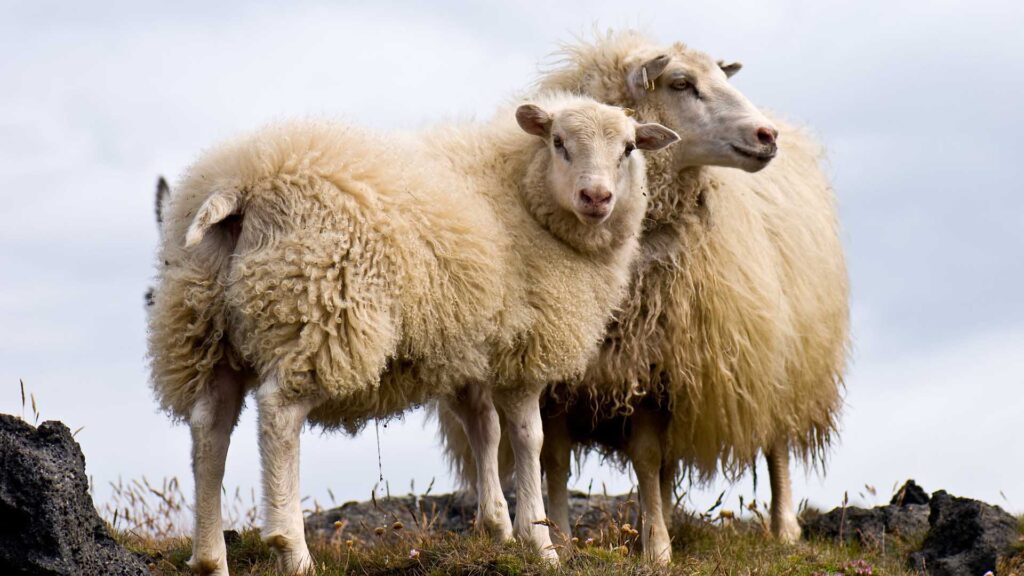
There are more sheep than people in Iceland
There are about half a million sheep in Iceland, but only around 360.000 people when this blog is written. The sheep are bred almost exclusively for meat and wool. They are usually shorn twice a year, in spring and the fall, and then the wool is sold to spinning mills, both large and small. As was done in the old days, some farmers have started spinning their own wool again but with modern equipment. Here is the website of one such sheep farmer, and Hulda (The name of the farmer) can even knit you a sweater according to your wishes.
The two wool hair types of Icelandic sheep
The wool we get from our sheep is worked in a way to combines the two different hair types we get from the sheep.
One is the long, sturdy, coarse, water-resistant “tog, “which translates to rough wool. The other is the short, soft, warm “þel” (pronounced thel) which translates basically to fine wool.
The fine wool, þel, is close to merino wool in characteristics but is curlier, so it holds more air, which gives it better-isolating qualities. So, when combined with the tog, the yarn has incredible warmth and sturdiness and is water-repellent up to a point.
Even soaked through, the Icelandic wool can still keep quite a bit of warmth. Using the tog, the yarn is somewhat coarser than merino, alpaca, or any other type of wool, so some people find it scratches a bit. Most of our woolen clothes are meant to be worn as the middle or outer layer, on top of clothes instead of next to the skin.
In my childhood, complaining of scratchy woolen underwear was considered a weakness and almost unpatriotic. Fortunately, we don’t force our children to wear Icelandic wool with the rough tog next to their skin anymore. To see the difference between the tog and the þel, here is an excellent blog about it.

Cleaning the wool
Before any spinning is done, the wool has to be cleaned. The Icelandic sheep roam free during the summer; they lay down in mud puddles, walk across sands, sleep in heather, and get a bit dirty (but very happy).
In winter, they stay inside since the winter is too harsh for them to survive outside. As nobody has invented sheep showers yet, they get pretty dirty during winter as well.
Actually, they are a lot dirtier after the winter inside the sheds than in the summer outside. In the summer, they also walk in lakes and creeks and get some natural baths.
They are always shorn in the fall when the wool is rather clean. Occasionally, they are shorn in spring as well to get rid of the dirty winter coat. The spring wool is much more challenging to clean and fetches much lower prices than the fall wool.
Animal urine was used before soap was available
When it is time to clean the wool, it has to be “beaten” first. That is done to get the larger pieces of dirt, heather, grass and other bits out of it. Before soap was available, the wool was washed in a mixture of water and animal urine before being rinsed in running water (usually a creek). Animal urine has good cleaning qualities to do the high urea content. Even in my childhood, washing your hair with cow urine was considered beneficial. It was supposed to give your hair a high gloss. I never tried it.
The four natural colors of the Icelandic wool
After cleaning the wool, it is sorted by color. There are four natural colors of Icelandic wool: white, grey, black, and brown.
These can then be combined to get scales of greyness and brownness.
Next, it is finger-combed and then combed with special wool combs. Then the threads are pulled out of the combs and loosely twisted together by hand before being spun on a spinning wheel.
My grandmother would let me assist in combing the wool with her wool combs. But as she passed away when I was eight, she never got around teaching me to spin the wool. She had a loom and used the fine-spun yarn to make curtains and table runners and the rougher wool to make rugs.
She also had an old knitting machine which she used to knit finer clothes and sell. She was a poor farmer’s wife who got all three of her children through college in the forties and fifties. She did that partially by selling her knitwear.
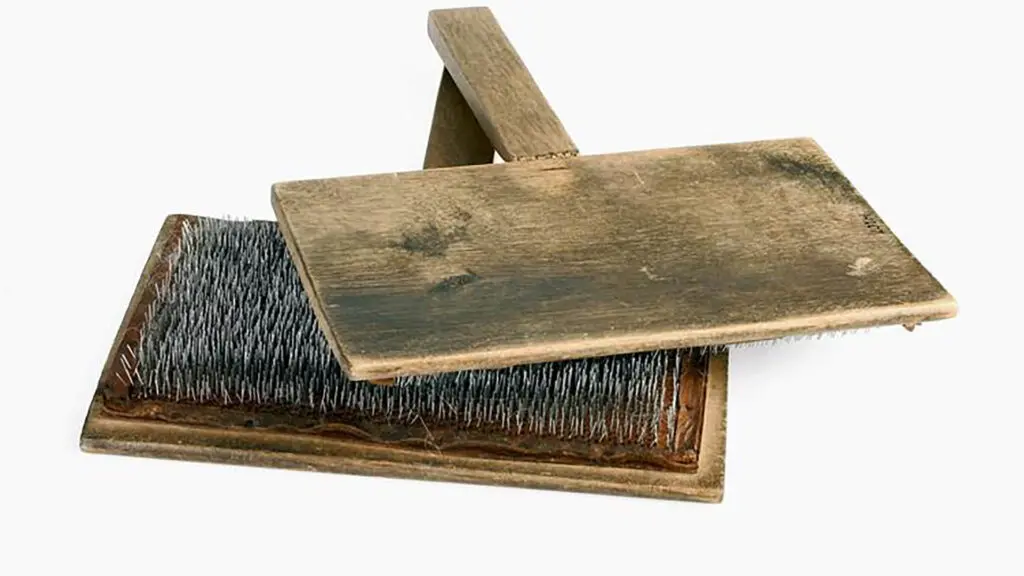
Wool dyed with cow urine
Besides the natural colors, the yarn can be dyed blue, violet, red-brown, green, and yellow with plants found in Iceland.
However, dying would only be done for the most beautiful items.
For blues, blueberries (Vaccinium corymbosum) are used for the dying.
For violet hues, crowberries (Empetrum nigrum) are used.
Many plants were used to get different yellow nuances, such as Iceland moss (Cetraria islandica), which is actually a lichen. Dooryard dock (Rumex longifolius), creeping buttercup (Ranunculus repens), and lady’s bedstraw (Galium verum) can also be used.
To get a beautiful green color, you must put the wool in old, cold urine in a copper pot, together with common nettles (Urtica dioica).
Getting a red color is very difficult, and it can never be a high red. However, by soaking the wool for 1-2 weeks in new cow urine, which has to be changed every two to three days, combined with Iceland moss, you can get a reddish tint.
Today, you can, of course, get wool in almost any colour but they are not dyed with natural dyes.
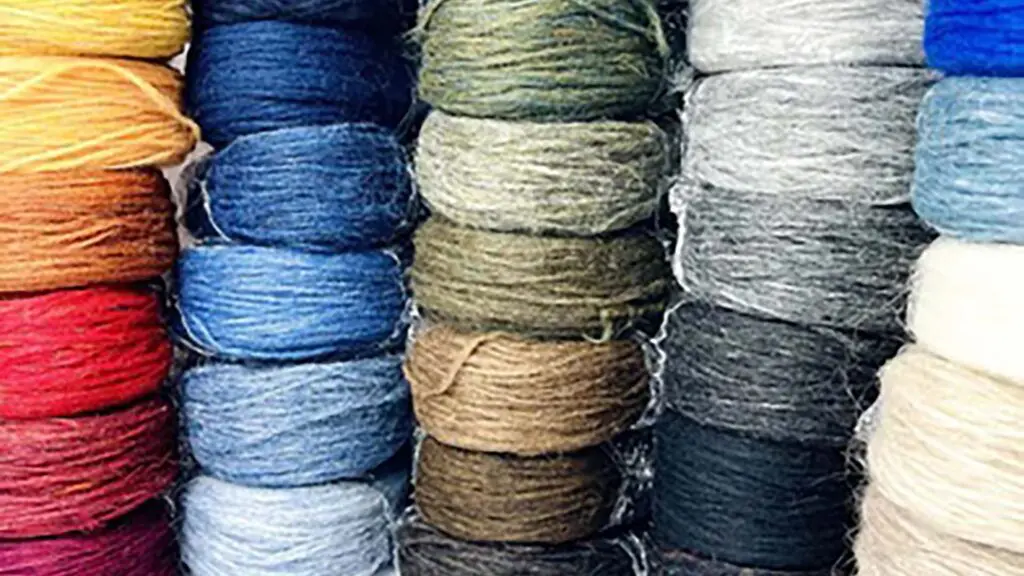
The use of Icelandic wool throughout the ages
All wool was woven until the 16th century, when knitting was introduced to Iceland, probably by German merchants. The oldest written source on knitting in Iceland is in a book from the second half of the 16th century. At this point in time, national debts were paid in knitting.
Woven wool cloth was used for almost all clothes, as cotton was still unheard of. Linen and silk were only available from sporadic foreign merchants at a very high price – particularly silk. However, after the introduction of knitting, this production method took over. It was a more comfortable and, in many ways, quicker method.
Homespun Cloth – Vaðmál
The woven cloth is called vaðmál. It was mainly a woman’s job to weave it, and they used a cumbersome loom to do the job. Vaðmál was also used as currency for many centuries, and the Icelandic vaðmál was considered exceptionally good.
In the Christian law chapter (Kristinna Laga þáttur) in one of Iceland’s old law books, Grágás, it says that one legal penny was 6 cubits of vaðmál. However, there were also provisions regarding its quality written into law. The vaðmál had to be the loom’s width and not narrower than that. It could also not be too skewed “so there is no more than an ulna difference in 20 cubits long vaðmál.”
The law stated how much women should weave in a week and how much they and the farmers should be paid for it. “Female weavers should weave 22 cubits of vaðmál per week and should have light if they want. They should be paid 8 cubits per week.” One cubit at that time was usually about 50 centimetres or 19.6″.
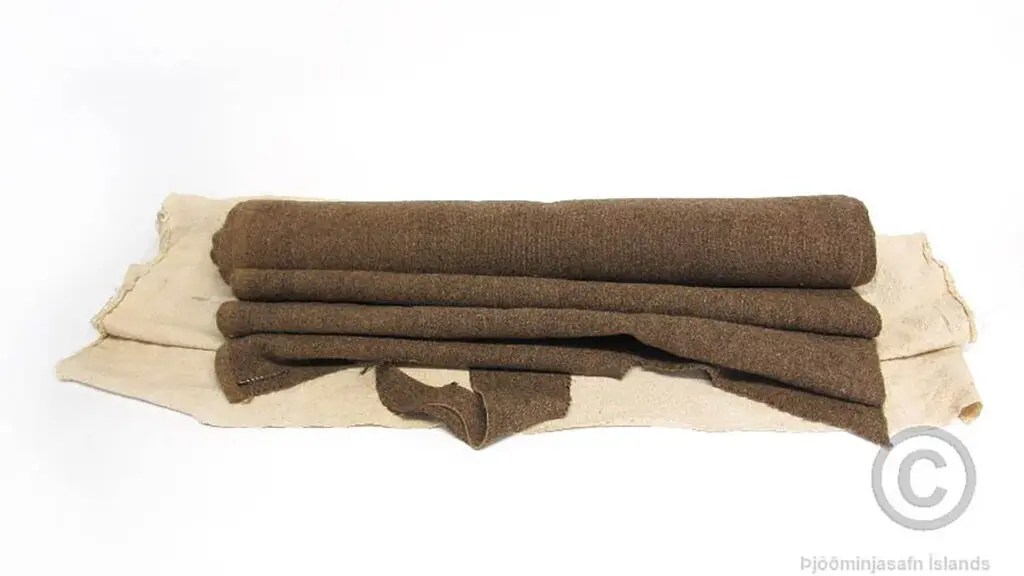
Knitting was a winter task done by everyone in Iceland
Knitting became one of the winter tasks on every farm. Everyone did their share, both men and women, during the long winter nights. Children were taught to knit at an early age, and they were supposed to knit a certain number of items each winter. The men would sometimes even knit on their way to and from the sheep sheds.
One person would quite often entertain everyone in the evenings by reading aloud by candlelight, reciting stories, or singing, and the rest would knit – often in the dark.
Wool and knitted items were export goods
Knitting was used both to produce clothes for the household and export.
Farmers would take the knitted goods into the towns. The local merchants would take them in return for flour, sugar, tobacco, and alcohol. Mostly, these knitted items for export would be sweaters and mittens. An export record was set in 1849, when more than 8000 sweaters were exported. Records for mittens and socks were established in 1764 and 1806. More than 280.000 pairs of mittens were shipped at the beginning of the 19th century, and more than 250,000 pairs of socks in 1764.
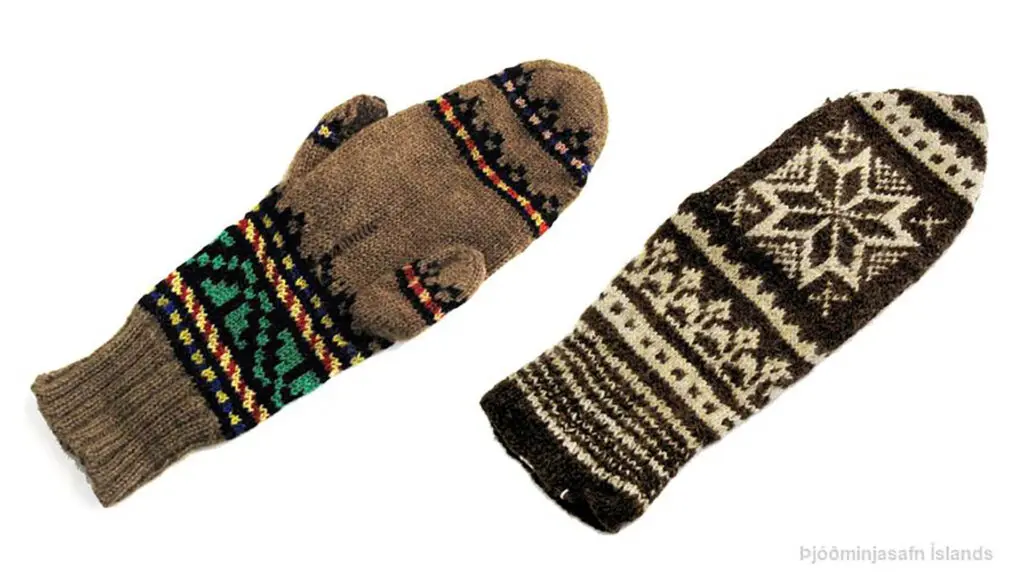
It was considered reasonable for female farm labourers to knit socks every day. Additionally, it was considered normal for them to knit six sweaters without sleeves or four whole sweaters in a week.
Outerwear items would often be fulled. That is done by beating or roughing it up in water (preferably hot), so it becomes thicker and denser. This adds to the isolation and water-resistance properties of the garment. This also shrinks the garment, so it would have to be knitted larger than the finished product was supposed to be.
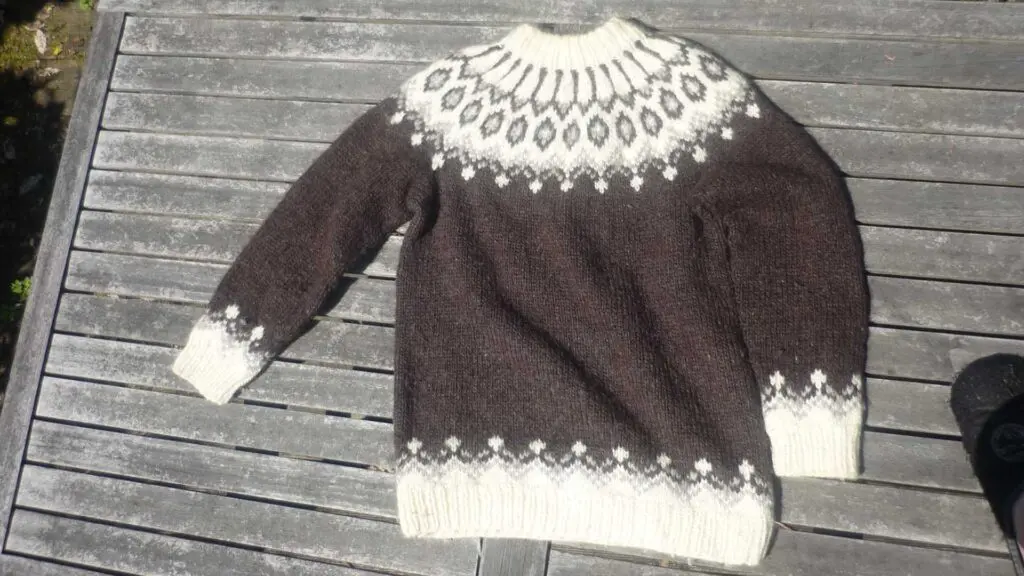
The Icelandic sweater – the lopapeysa
The ubiquitous Icelandic sweater, or lopapeysa, which you can find in all the tourist shops, is a relatively new design, dating back to the 1940s.
As seen in the picture above, it has a solid-coloured body and sleeves with a pattern on the bottom of the body and the sleeves and on the yoke. Norwegian and Swedish knitting designs and Greenlandic costume beadwork influenced the yoke pattern.
This type of sweater is knitted on circular knitting needles, so it is seamless. The sleeves are knit in a circle on five knitting needles until there are enough stitches to transfer them to a short circular needle. Most of the sweater is knitted like this. That means you never have to purl a stitch apart from the cuffs, the bottom and the collar. There you have to alternate between a knit and a purl stitch. The knitting goes much faster, and a seamless sweater is more comfortable and less bulky. Most Icelandic knitters prefer to knit on circular needles and often adapt foreign patterns to suit circular needles.
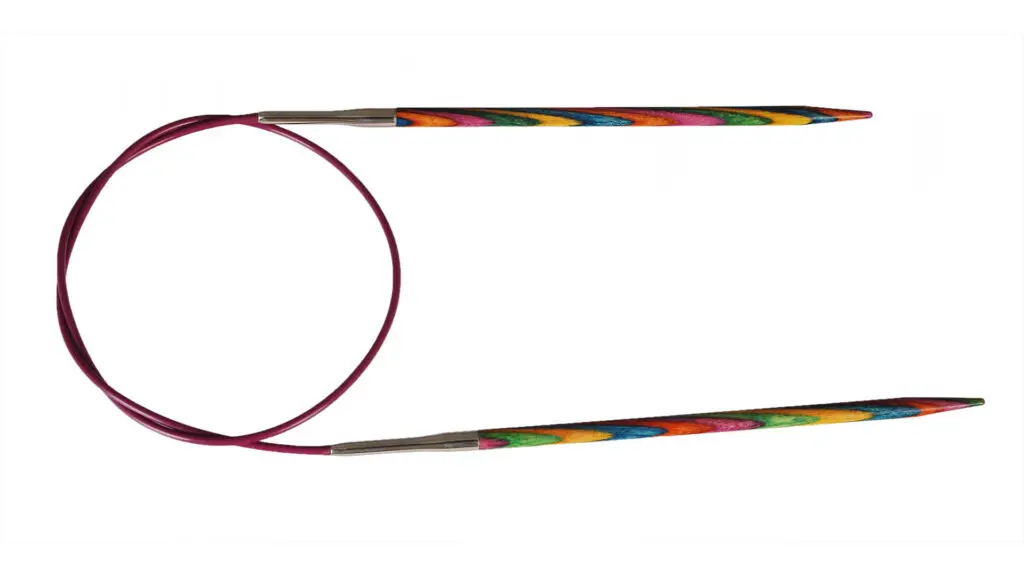
The lopapeysa sweater as a cardigan
The lopapeysa also exists as a cardigan. The sweater is knit as a whole sweater, then cut open down the middle and buttons, or a zipper added.
Although the lopapeysa seems to be a very touristy thing to get, most Icelanders have at least one of them. If you decide to get one, you are not buying just something for tourists.
Most Icelanders have one made by themselves or a family member (often a granny), as knitting is a popular hobby in Iceland. All children learn how to knit in school, it is part of their textile studies. Although knitting is mainly done by women, I know a few male knitters. A man who knits is sometimes seen as a bit unusual but not effeminate or gay.
The Lopapeysa is protected today
The Icelandic lopapeysa has recently been given protected status. Knitted items that do not adhere to specific criterium cannot, legally, be called lopapeysa. For the sweater to be called lopapeysa, these conditions have to be fulfilled:
- The wool used for a hand-knitted Icelandic lopapeysa must come from Icelandic sheep.
- The wool used to knit the sweater must be new, not recycled.
- The sweater has to be knit from Lopi wool (the Icelandic wool used for knitting a lopapeysa).
- The sweater has to have a circularly knitted yoke with a pattern from the shoulder to the neckline.
- The sweater has to be hand-knitted in Iceland.
- The sweater has to be seamless.
- The sweater can be whole or open (cardigan)
The traditional Lopi wool uses three strands
Traditional lopapeysa is knit with three-ply Lopi wool, which you can buy already wound together. You can wind the three strands together yourself with unwound wool. The unwound wool is less expensive but winding it is a bit of work. Two-ply lopapeysas are also popular – they are lighter and less bulky than the three-ply ones.
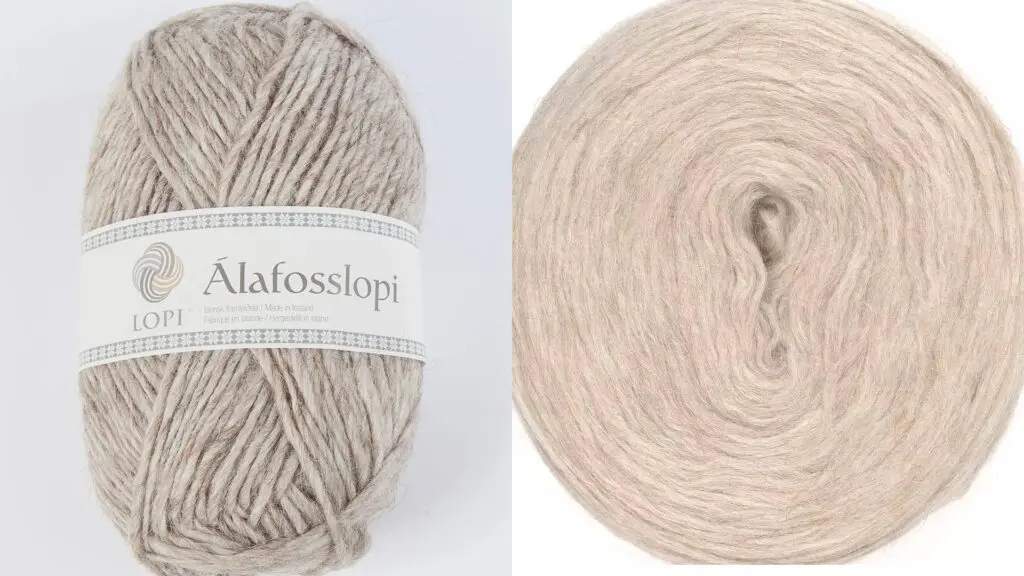
The Handknitting Association of Iceland
In 1977, a group of knitters, mainly women, formed the Handknitting Association of Iceland. The goal was to knit sweaters to sell, particularly to tourists. The association would buy wool in bulk and sell it to members at a preferential price and sell the finished sweaters in the shop they established. Today, the association counts thousands of members, and I am proud to be one of them.
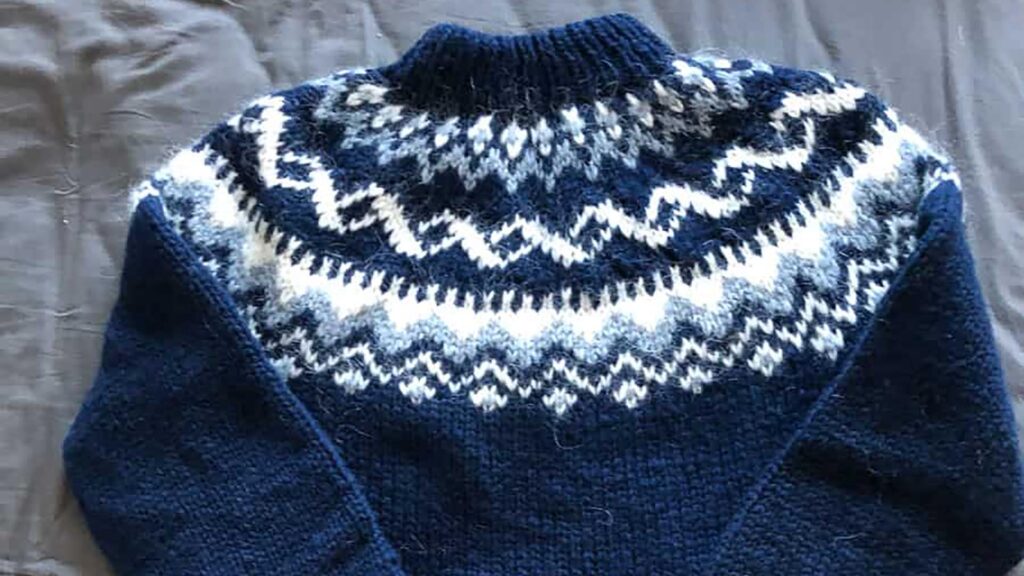
The qualifications to be a part of the association
To be accepted as a knitter, you must produce sweaters that conform to strict guidelines. There is no time limit on how long it takes you to knit the sweater. You can knit five per week or five per year – it is up to you. A highly experienced and fast knitter can finish a lopapeysa in a day. I use a bit of my spare time for knitting, so I usually get one done monthly. I love to knit, and getting paid a bit for it is pretty nice.
Where to buy your lopapeysa wool sweater?
If you want to be sure to get a genuine lopapeysa, you can trust the Handknitting Association. They have three shops in Reykjavík, with hundreds of lopapeysas in all sizes and colors.
If you go to other stores, ask whether they are made in Iceland. Some shops ship the wool to Eastern Europe and get knitters to knit them there for a fraction of the cost that an Icelandic knitter gets, but the buyer’s price usually remains about the same. And it cannot be called lopapeysa if it wasn’t made in Iceland!
At Kolaportið Flea Market, you can also find women selling their own hand-made lopapeysas. These are usually priced lower than in the stores, but there is less variety and no changing rooms. However, should you be in town on the weekend, it is worth checking the Flea Market out for lopapeysas and other interesting goods. You can also find good second-hand lopapeysas at the Flea Market.
Check out our Private Shopping and Sightseeing Tour to find the best spots to buy lopapeysa!
Other woolen goods from Iceland
The lopapeysa is THE ultimate woolen buy in Iceland, but there are plenty of other Icelandic woolen products, both hand-made and mass-produced, such as hats, mittens, gloves, scarves, shawls, ponchos, headbands and socks, for men, women, and children. You can also find lovely throws, pillows, and other beautiful items for the household, either for yourself or as gifts.
Sheepskins and their use
With the wool attached, the sheepskin is also used to make mittens, slippers, hats, and coats. These keep you very warm, and they are also waterproof. I got my first pair of sheepskin mittens when I was about seven years old, and they have regularly been upgraded, both in size and when the old ones got too worn out. When I was a teenager, my friends and I drew patterns on them with ballpoint pens, much to our parents’ chagrin.
At the end of the day
I am almost certain that every Icelander and household in Iceland has Icelandic woolen items, clothes or throws. We are very proud of our wool, and it is a bit like us: slightly prickly on the outside but soft and warm on the inside.
Please signup HERE for our newsletter for more fun facts and information about Iceland!









